Hat trick—The Ioniq Plug-in Electric Hybrid Makes Three
Before 2017 there were no “Ioniq†models in the Hyundai line-up. Now there are three of them. First came the 2017 Ioniq Electric, then the 2017 Ioniq Hybrid, and now the 2018 Hyundai Ioniq Plug-in Hybrid Electric Vehicle (PHEV). Hyundai engineers and product planners obviously have been working overtime.
The 2018 Hyundai Ioniq PHEV is one of five hybrid or electric cars currently sold by Hyundai, and it will be joined by two more in the next couple of years. Hyundai’s affirmation of electrified vehicles is to be applauded, as more on the market accelerates their acceptance by consumers. But why wait any longer, especially when the Ioniq PHEV delivers all your short and distance driving needs?
Gasoline or Electric: Whatever It Takes
The 2018 Hyundai Ioniq PHEV powertrain combines a 1.6-liter, four-cylinder engine delivering 104 horsepower (hp) and 109 pounds-feet of torque, with a 44.5 kW electric motor adding 60 hp. The beauty of the electric motor is that you can drive as fast as 75 mph, but also have instant torque at any speed. The driving range in all-electric mode is 29 miles. It delivers 52 MPG in hybrid mode; and 119 MPGe in EV mode. MPGe is a measurement of how efficient a car powered by electricity is, using the same amount of energy as is contained in one gallon of gasoline. Use MPGe to compare to other electric vehicles.
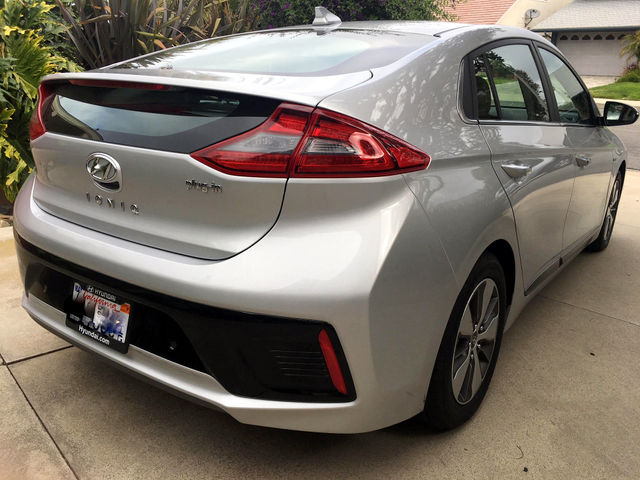
Staying away from the Sport mode, and keeping in the Eco mode, in 265 miles of conservative, 65-percent highway/35-percent city driving, we averaged 63.2 mpg. There is even a dash readout summarizing your driving pattern. Fuel economy numbers reported by Clean Fleet Report are non-scientific and represent the reviewer’s driving experience, in our reviewer’s city. If you live in cold weather, high in the mountains or spend time in the city or stuck in rush hour traffic, then your numbers may differ.
Mated to Hyundai’s six-speed EcoShift dual clutch transmission (DCT) with paddle shifters, the powertrain delivered smooth and efficient performance regardless of which propulsion source was being used. Clean Fleet Report was impressed with the powertrain’s seamless operation. Torque for highway ramp sprints and passing 75+mph big rigs was easy and effortless, but acceleration was only adequate, and certainly not fast.
When driving, the 8.9-kWh lithium-Ion polymer (li-ion) battery is replenished through the regenerative charging system. This technology converts kinetic energy into electric energy and stores it in the battery when applying the brakes or coasting. This process can be viewed on a dash gauge where you can watch the power flow into and out of the battery and electric motor. The Ioniq PHEV’s regenerative braking required little pedal modulation and had a confident feel; it’s part of the braking system of all-wheel anti-lock brakes (ABS) with electronic brake-force distribution, brake assist, electronic stability and traction control. The Ioniq PHEV had solid, straight and true stops.
To get a full charge from empty it takes about eight-and-half hours with a 120V (Level 1) outlet or about two-and-a-half hours using a 240V (Level 2) charger. The Ioniq PHEV is not equipped with a DC fast-charge port.
Out on the Road
The 2018 Hyundai Ioniq PHEV will be used mostly as an around town and commuter car. Weighing in at 3,417 lbs., it has good manners on the highway and felt sturdy and planted to the road. Even Southern California’s grooved concrete freeways, which can cause cars to track with the grooves or feel every seam and patch, were not a problem. In town, the motor-driven power steering is light for easy maneuvering and gets a bit heavier on the freeway. External noise is minimal. The .24 drag coefficient and active grille shutters help it slip through the wind.
Looks Like A Car

The Ioniq PHEV has smooth body surfaces, with few creases or sharp edges. It bucks the trend for electrified cars to be wedge shaped and has a tasteful and stylish grille. The front LED daytime running lights are standard, positioned just below the swept-back projector headlights. The five-spoke, 16-inch Eco-spoke alloy wheels were built to cut through the wind and the Michelin 205/55R Energy Saver all-season tires were fuel-smart and quiet.
The hatch, with a built-in combination deck lid/spoiler that divides the glass, is bordered on each side by LED tail lamps. It took some getting used to–looking in the rearview mirror and seeing the horizontal deck lid/spoiler in the rear window–but after some mental and visualization adjustments, it became normal and natural and was not an issue.
Interior Built for Comfort
Clean Fleet Report’s 2018 Hyundai Ioniq PHEV Limited’s interior was nicely appointed with the dash and doors outfitted with soft and hard plastic surfaces, accented by a very tasteful use of brushed aluminum trim pieces and piano key buttons. The gauges and controls were conveniently located, with a digital dash having several settings to read a wide assortment of data. The center console dividing the heated, leather seats (power adjustable with memory for the driver and manual for the passenger) has gear selector buttons, which was a nice surprise and design to save space.

The rear seats are made for grown humans: two comfortably or three for short jaunts. Divided by the fold down armrest (with cup holders), there was ample leg, shoulder and head room. For storage, the rear seat folds 60/40 to provide excellent cargo space when you’re off on a long weekend road trip. However, with the rear seat back in the upright position, trunk space is smaller than on the Ioniq Hybrid as the EV battery cuts into storage space.
Clean Fleet Report’s Ioniq PHEV Limited came with the optional Ultimate Package that included an 8.0-inch color touchscreen for navigation and infotainment (information and entertainment). Our car had the optional eight-speaker Infinity Premium Audio system with HD FM/AM, SiriusXM (90-day subscription included), Apple CarPlay and Android Auto. All of which can be managed by the leather-wrapped steering wheel mounted controls. Other features of the system include iPod/USB ports, AUX and audio input jacks and Bluetooth for voice controls and hands-free telephone calling.
Convenience features include dual automatic climate control, tilt and telescopic steering column, power windows with one-touch down, power door locks, power and heated foldaway exterior mirrors with turn signals. Other standard features are proximity key entry with approach lights, electronic parking brake, push button start, security alarm, a tire pressure monitoring system and a tire puncture repair kit, which replaces a spare tire.
Optional features include wireless phone charging for compatible phones (Qi), power tilt-and-slide sunroof, carpeted floor mats, auto-dimming rear view mirror with Homelink and interior LED illumination.
Safety Features
Standard and optional safety features include seven airbags, blind spot detection with cross traffic alert and lane change assist, lane keep assist, rear view camera, automatic emergency braking, smart cruise control with stop/start and hill start assist. Part of the options included headlights with dynamic bending when cornering. This was a very convenient safety feature.
The 2018 Hyundai Ioniq PHEV has not been rated by the National Highway Traffic Safety Administration or the Insurance Institute for Highway Safety.
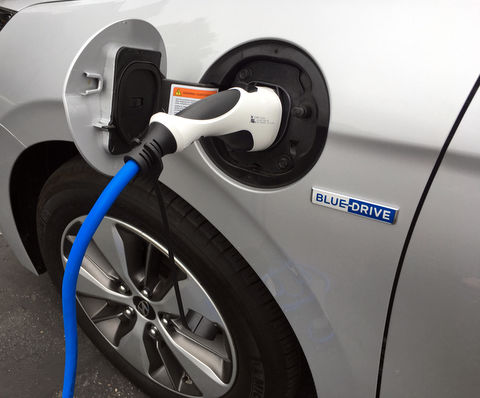
Pricing and Warranties
Clean Fleet Report’s 2018 Hyundai Ioniq PHEV Limited had a MSRP of $29,185. The optional Ultimate Package and carpeted floor mats added $3,750, and the total came to $32,935. All prices do not include the $950 freight and handling charge.
The Ioniq PHEV comes with these warranties.
Hybrid Battery Lifetime
New Vehicle Five Years/60,000 miles
Hybrid Systems 10 years/100,000 Miles
Powertrain 10 Years/100,000 miles
Anti-Perforation Seven Years/Unlimited Miles
Roadside Assistance Five Years/Unlimited Miles
Observations: 2018 Hyundai Ioniq PHEV Limited
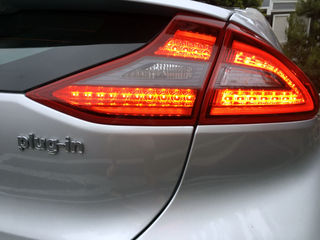
If you are in the market for an electrified car for the first time, or to upgrade your existing hybrid, the 2018 Hyundai Ioniq PHEV should be high on your shopping list. The Ioniq family of electrified cars gives you the option of one that uses no gasoline, or two that use a combination of gasoline and electricity. All with the confidence of a lifetime battery warranty.
You will be buying a stylish sedan that isn’t wedge-shaped just to optimize some electric batteries, and you’ll get an interior made with eco-friendly materials.
Before visiting your Hyundai dealer, make sure to make an appointment with a factory-trained hybrid vehicle specialist. Then treat yourself to a lengthy test drive and see for yourself how a plug-in hybrid could enhance your lifestyle.
Whatever you end up buying, enjoy your new car and as always, Happy Driving!
Related Stories You Might Enjoy—PHEV Competitors & Hyundai-Kia News
News: 2019 Ford Fusion Energi Adds Range, Tech
Road Test: 2018 Kia Niro Plug-in Hybrid (John’s view)
News: 2018 Hyundai Sonata Hybrid at Chicago Auto Show
Road Test: 2018 Kia Niro Plug-in Hybrid (Steve’s view)
Road Test: 2018 Honda Clarity Plug-in Hybrid
Flash Drive: 2017 Ford Fusion Energi
Flash Drive: 2018 Hyundai Ioniq PHEV
The Other Part of the Triplets
Road Test: 2017 Hyundai Ioniq Hybrid
Road Test: 2017 Hyundai Ioniq Electric
Comparison Test: 2017 Hyundai Ioniq Hybrid & Electric
Disclosure:
Clean Fleet Report is loaned free test vehicles from automakers to evaluate, typically for a week at a time. Our road tests are based on this one-week drive of a new vehicle. Because of this we don’t address issues such as long-term reliability or total cost of ownership. In addition, we are often invited to manufacturer events highlighting new vehicles or technology. As part of these events we may be offered free transportation, lodging or meals. We do our best to present our unvarnished evaluations of vehicles and news irrespective of these inducements.
Our focus is on vehicles that offer the best fuel economy in their class, which leads us to emphasize electric cars, plug-in hybrids, hybrids and diesels. We also feature those efficient gas-powered vehicles that are among the top mpg vehicles in their class. In addition, we aim to offer reviews and news on advanced technology and the alternative fuel vehicle market. We welcome any feedback from vehicle owners and are dedicated to providing a forum for alternative viewpoints. Please let us know your views at publisher@cleanfleetreport.com.

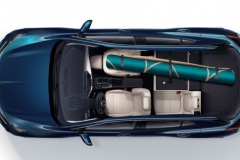
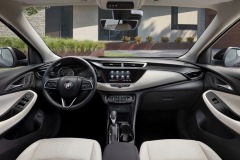
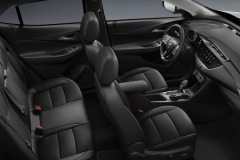
3 thoughts on “Road Test: 2018 Hyundai Ioniq Plug-In Hybrid Limited”